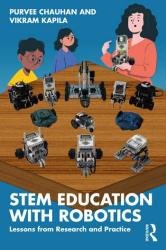STEM Education with Robotics: Lessons from Research and Practice
- Добавил: literator
- Дата: 17-03-2023, 03:28
- Комментариев: 0
 Название: STEM Education with Robotics: Lessons from Research and Practice
Название: STEM Education with Robotics: Lessons from Research and PracticeАвтор: Purvee Chauhan, Vikram Kapila
Издательство: Routledge
Год: 2023
Страниц: 288
Язык: английский
Формат: pdf (true)
Размер: 10.2 MB
This book offers a synthesis of research, curriculum examples, pedagogy models, and classroom recommendations for the effective use of robotics in STEM teaching and learning. Authors Chauhan and Kapila demonstrate how the use of educational robotics can improve and enhance student learning and understanding within the STEM disciplines.
The book explores the implementation of design-based research (DBR), technological-pedagogical-and-content-knowledge (TPACK), and the 5E instructional model, among others. Chapters draw on a variety of pedagogical scaffolds to help teachers deploy educational robotics for classroom use, including on research-driven case studies, strategies, and standards-aligned lesson plans from real-life settings.
The science and technology of robotics design, manufacturing, and application has grown by leaps and bounds over the past decades. This revolution has been fueled by developments both in software (particularly Machine Learning and Artificial Intelligence) as well as better understanding of the mechanics of movement and object manipulation. In that sense, robotics is almost a perfect encapsulation and convergence of ideas in the STEM (science, technology engineering, and mathematics) disciplines.
As we look to the future, it becomes increasingly important that we understand the role of the STEM disciplines in defining and determining our future. And robots, by extension, will be an important part of this. Thus, since education is inherently about preparing our next generations for the future, we must consider ways to help youth in our schools and universities become more knowledgeable about what these technologies mean for us.
The first part of the book seeks to involve its readers through three chapters to gain a strong foundation in the fundamentals of educational robotics, understand its significance, appreciate its connections with science, technology, engineering, and mathematics (STEM) education, and be exposed to its myriad applications. The first chapter, Transformational Learning with Educational Robotics, provides a detailed description of the intersection of robotics with integrated STEM and affordances of robotics in engendering active learning experiences. The second chapter, Applications of Robots in Educational Settings, builds on the fundamentals, through a detailed literature review, by introducing the foundational theories, instructional approaches, and roles and applications of robotics in varied educational settings. Finally, the third chapter, Teaching STEM with Robotics: Synopsis of a Research-guided Program, exposes the readers to the design and outcomes of a multi-year research effort that employed a wide array of theoretical constructs to implement a teacher professional development program and co-create novel robotics-based STEM curricula in partnership with teachers.
Technology in education can involve myriad tools such as computer-based learning, integration of immersive VR and AR technologies, game-based learning, maker tools such as 3D printers, robots, etc. The past several years have witnessed a significant growth in interest and efforts by educators in transforming interdisciplinary learning experiences with the use of robotics as a technology tool in classrooms. Robotics is an interdisciplinary branch of engineering that integrates computer science, electrical engineering, electronics engineering, and mechanical engineering. It entails designing, building, and using robots, all of which require applications of fundamental concepts of physics, mechanics, electricity, electronics, sensing, actuation, microcontrollers, computing, and engineering design, among many others. Robotics is increasingly being used in many real-world settings and it has found a plethora of applications in health care, manufacturing, security, entertainment, space exploration, and education.
As students use educational robots in a classroom, their joyful memories of playing with construction toys may encourage them to engage in robotics-based learning activities. The availability of a plethora of LEGO TECHNIC and VEX construction blocks enables learners to build and test various configurations of structures and mechanisms for their robotics creations. The electronic hardware elements of educational robots also support quick adoption and integration with their plug-and-play capabilities. Furthermore, educational robots equipped with a multiplicity of sensors allow learners to explore in varied ways the state of the robot and its environment. Finally, the now common visual programming environments of educational robots engage learners in rapid prototyping and testing of diverse solution strategies.
This book will benefit STEM teacher educators, and STEM education researchers.
Скачать STEM Education with Robotics: Lessons from Research and Practice
Внимание
Уважаемый посетитель, Вы зашли на сайт как незарегистрированный пользователь.
Мы рекомендуем Вам зарегистрироваться либо войти на сайт под своим именем.
Уважаемый посетитель, Вы зашли на сайт как незарегистрированный пользователь.
Мы рекомендуем Вам зарегистрироваться либо войти на сайт под своим именем.
Информация
Посетители, находящиеся в группе Гости, не могут оставлять комментарии к данной публикации.
Посетители, находящиеся в группе Гости, не могут оставлять комментарии к данной публикации.
